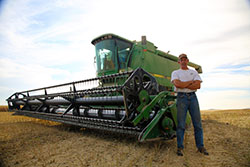|
The Germination Trigger.
How do get a No-till stand in Kansas Soybean production.
Seed Row Saturation, Soybean Production. SRS reviewed at 20, 30,
40 and 50 gallons per acre of seed row water saturation with a 20
inch Deere planter.
What rate of water makes the difference in June Planting of
Soybeans on sandy, high pH, eroded soils of the Great Plains?
At Wagon Bed Springs, Along the Cimmaron River of SW Kansas.
Right here within just a few hundred feet,
is where Jeddediah Strong Smith, famous mountain man and guide, was
murdered by the Comanche Indians in 1831.
The Dry Trail of the Sante Fe in the background.
Sandy and eroded Dust Bowl soils, with
very low CEC are observed in the pivot corner in the foreground.
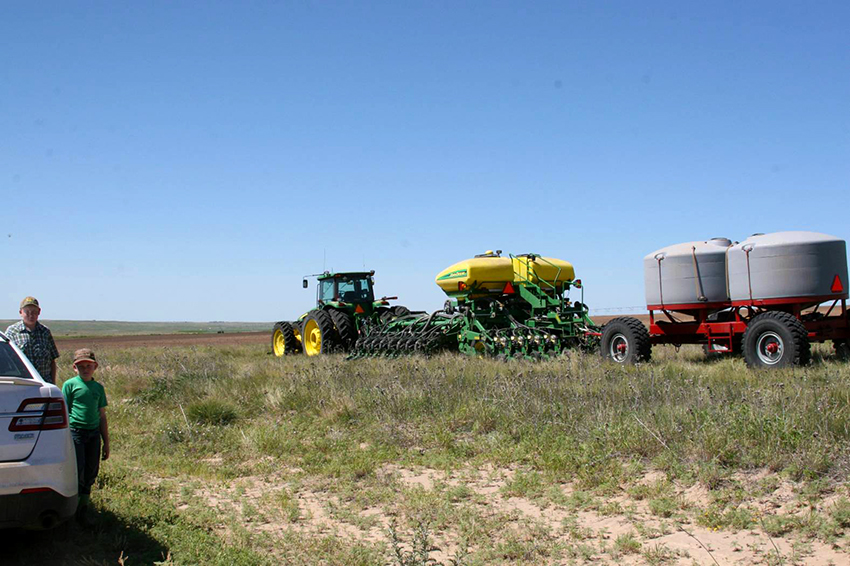
Adequate Machinery is required, 2,500 gallon trailer tank,
and PD pumps with a good manifold and delivery method.
Exactrix SRS tubes help.
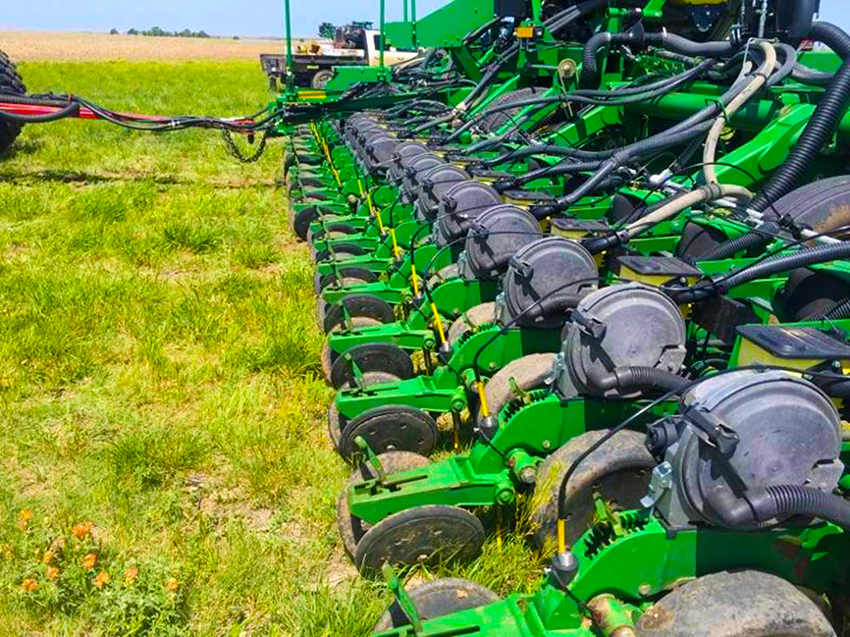
Simple to set up, Looking Glass manifolds
allow sectional control….application at 1% CV is critical for new
germination materials like ZnSO4 and hydrogen peroxide.
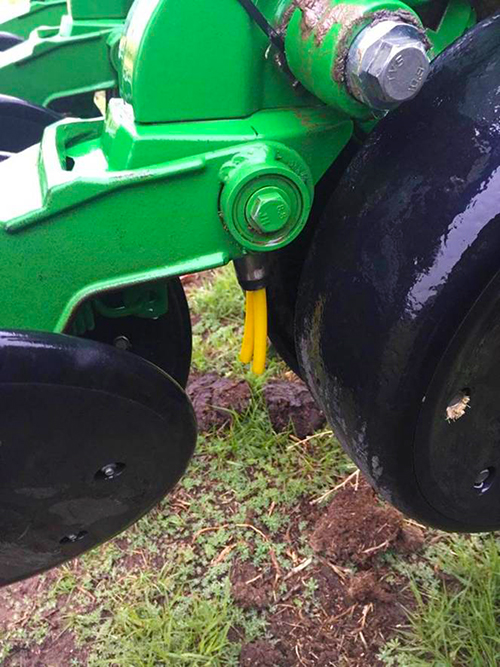
Dual tubes required at 65 gallons per acre on 20 inch spacing. No
splashing on the planter is allowed with MGPA.

PD pumps from Exactrix require less than 3 to 5 gallons per minute
of hydraulic flow. The hydraulic flow control valve is key to using
very little oil flow so the planter hydraulic circuits can work
properly.
Exactrix systems do not use Pulse Width modulation,
the system is the standard of the industry Load Sense with
Pressure Compensation circuits. A power
head valve is required to reduce oil flow to 3 gallons nominal per
minute.
4 cylinder pumps are usable on 30 to 50 foot planters at maximum 50
gallons per minute. The pump actually over
revs to 650 rpm at 10 psi maximum pressure. Double bypass is
required.
6 cylinder pumps are useable on 40 to 80 foot planters at 70 gallons
per minute. The pump is over reved to 650
rpm at 10 psi maximum pressure. Double
bypass is required.
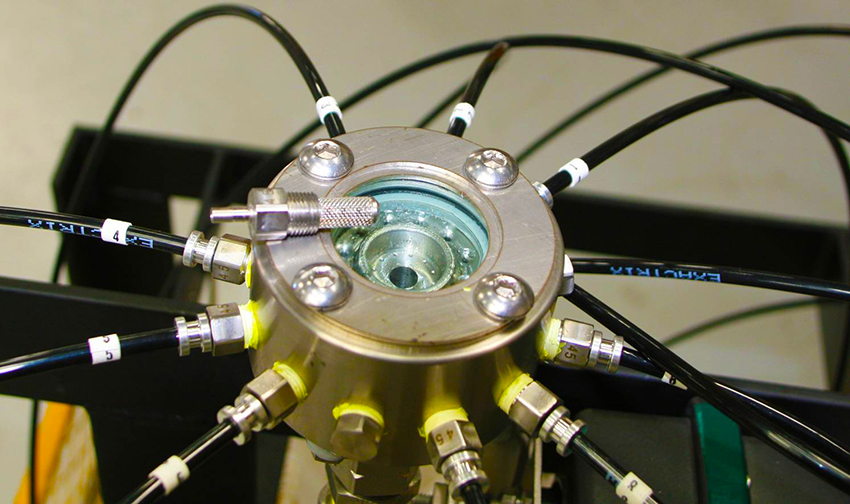
Looking Glass Manifolds handle high water flows. Allow sectional
control, Line filters can be installed but are not normally
required. Large final filters are not required so long as
recommended stimulants, and certain commercial fertilizers
are used.
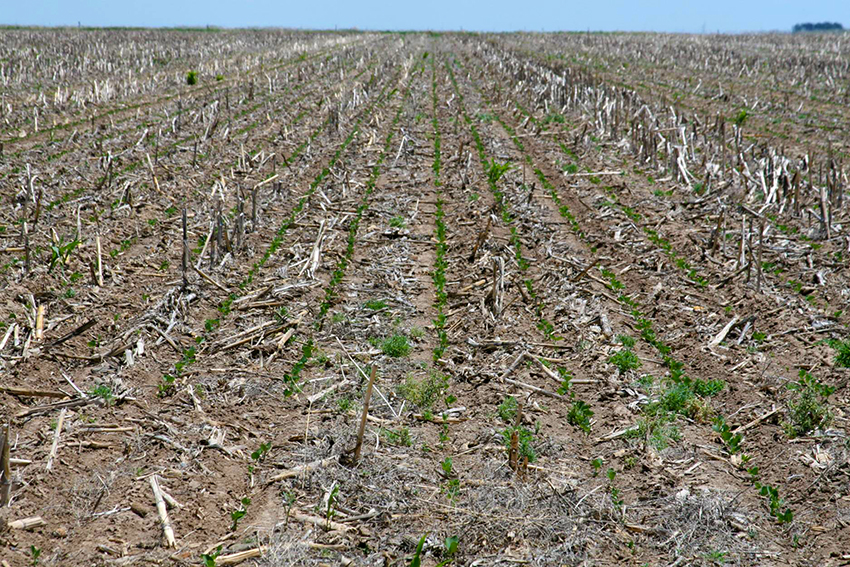
At 40 and 50 gallons per acre the stands were up and going 3 to 4
days ahead of the 30 and 20 gallon rates of water per acre. June 19,
2017 a lunch time survey and discovery
with Jay and Max McClure.
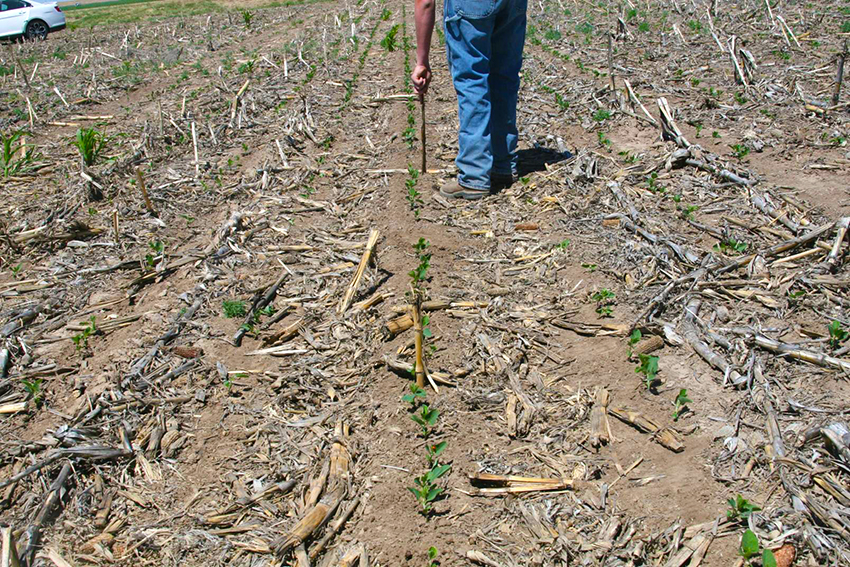
Seed Row Saturation, Soybean establishment, Hugoton Kansas. June 19,
2017, Dryland Soybeans at 40,000 population on 20 inch row spacing.
Deere 1710 planter.
Exactrix SRS Injection tubes.
Jay McClure and Maximillian McClure, the
Max Man. Both young mean learned the value of SRS.
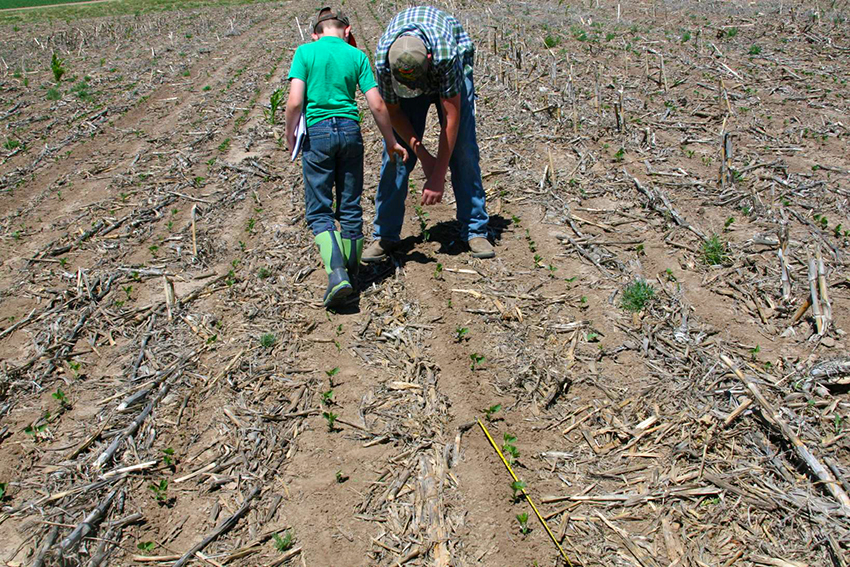
Rod Row Samples at 16.5 feet. A straggler is a plant that is
just emerging and obviously well behind (9 to10 days) the soldiers
of war.
Something did not trigger the germ properly producing a straggler.
Ample SRS water was not the problem. The hard seed coat or a weak
germ in the seed.
1. 50 gallons per acre. 23 plants and 1 straggler.
2. 40 gallons per acre. 24 plants and 2 stragglers.
3. 30 gallons per acre, 20 plants and 2 stragglers.
4. 20 gallons per acre, 19 plants and no stragglers.
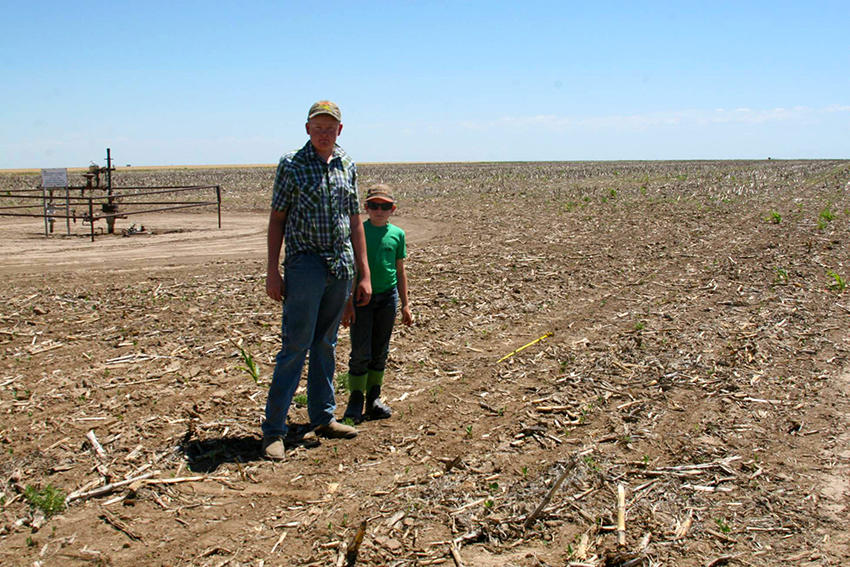
Bad News Bears, Worst stand, Compacted traffic area, low water in
SRS at 20 gallons per acre.
This area was not used in the tests, but
indicative of 2 problems at once. Poor stands could have been
corrected with ample germinating water.
Being conservative on the water is not a good plan with field
compaction, roads and unplanned weed areas in the field.
The costs to apply SRS is about $2.00 per acre, Hauling costs are
anticipated to be minimal.
The weeds utilization of soil stored, germinating moisture can cause
a blank out in the stand.
SRS works very well in Kansas conditions,
and is applicable in Canola production 100% of the time,
with ZnSO4 and other components of the germination trigger.
Scientific Notation
“The Osmotic Gradient is improved in the germination environment of
the seed with SRS techniques”, “Thus soils with right amount of
oxygen and water are aerobic (oxygenated). The result is conversion
of starches to sugars which absorb water more readily to create a
strong radical and coleoptile”.
Aerobic soils with adequate water in the germination zone (44% seed
moisture) allows the radical root to rapidly elongate with a greater
diameter and more turgor pressure for the Coleoptiles, the mystery
is now a functional part of Canola and Soybean production, and
Sunflowers. The soil must be aerobic or loaded with Oxygen and yet
it must have about 44% water potential to the seed. This is another
reason to experiment with Hydrogen Peroxide to help keep the zone
oxygenated in case of heavy rains.
This is why irrigating the crop up does not work well because the
seed is exposed to a flooded condition and the process is now
anaerobic (no oxygen). The result of too
much water is the critical dormancy enzymes (abscisic acid) are not
oxidized in a flooded soil condition.
You can over-apply the water. Just enough water needs to be present
to increase the seed moisture from 10% to 44% water in barley
malting practices…Water can be excessive and no more should be
applied to the seed than to maintain the aerobic wet germination
condition for about 12 to 24 hours for Canola and up to 48 hours for
large seeds like soybean. It is important to allow an air drying
condition surrounding the seed row.
A combination of low humidity and just enough water to swell the
seed and expose the abscisic acid to the oxygen in the aerobic zone
is the goal. This also explains why a heavy rain after planting does
not always produce good stands if the water puddles or stands in the
row.
It has been demonstrated that during the imbibition of barley seed
under aerobic conditions, the level of abscisic acid, a natural
inhibitor of germination, decreases rapidly and germination occurs
shortly thereafter.
However, if the seeds are imbibed under anaerobic conditions
(flooded), abscisic acid is not degraded and the seeds do not
germinate (Yamada, 1985).
The trigger is ZnSO4, the kick starter for the hard seeds, The
purpose of the design is convert rapidly to sugars…much like malting
barley in some respects. There may be other products (MnSO4) that
help drive the germination process.
Too Raise Canola Well. Under warm to hot soil planting conditions
from 60 degrees F to 100 degrees F and soils with low OM and low CEC
an ideal tool, SRS, can be used to jump start Winter Canola into top
yields. A 99% stand in 4 days.
Technical Documents for winter and spring canola growers.
http://agronomy.emu.ee/wp-content/uploads/2017/04/Vol15nr2_Nazari.pdf

Your Great Plains Reporter,
Guy J Swanson.
Guy J Swanson Announces
Two Exactrix Meetings and Seminars.
Aug. 16, 2017. Winter Canola.
September 13, 2017 Corn, Husker Harvest Days,
Grand Island.
Winter
Canola Planting Seminar With SRS Technology.
A review
of 2017 Winter Canola production techniques.
Flea
Flicker Option in Winter Canola.
Get the Correct Information.
SEE YOU THERE!
Winter
Canola Planting Seminar With SRS Technology.
A review of 2017 Winter Canola production techniques.
You must call
509 535
9925 to sign-up.
Demonstration of SRS in Winter Canola Planting.
The acres are moving upward at exponential trends in Kansas.
Time to reflect and get the top producers on the front burner for
answers.
No story left untold…Get Answers fast and improve profitability.
Coffee and donuts at 8:30 AM…find your spot
and bring your note book.
Aug 16,
2017, Hugoton, Kansas, Hugoton Country Club and Golf Course.
8:30 AM door prize from Rubisco and Exactrix.
9:00 AM to 1:00 PM with hosted lunch.
Planting Winter Canola for Maximum Yields.
Seed Row Saturation Explained.
Side Dressing of Irrigated Winter Canola. Changes and plans.
Winter Canola Insurance Programs Explained.
Setting Yield Goals in Irrigated Production of Winter Canola.
What are the limiting factors?
Leaders and Presentations.
Leadoff discussion and presentations.
9:00, Emanuel Williams, Channel, Reviews 97 day corn leading into
Irrigated Winter Canola. Rotation with Winter Wheat is not the only
choice in irrigated Winter Canola production. We will also
discuss dryland production of Winter Canola and Chemfallow
techniques with SRS.
9:30 AJ Foster Reviews KSU/TKI test plots with
Rubisco Winter Canola…Conclusion of 2017 crop
Roundtable discussions with screen projections.
10:00 SRS reviewed, Developing a 99% stand with
planted winter Canola. Joel McClure, No-till Producer with SRS
technology.
10:15 Winter Canola, irrigated and
dryland insurance programs.
10:30 Brian Caldbeck, Rubisco Seeds,
Agronomist. New releases and propagation updates on Winter Canola on
the Great Plains.
11:00 Demonstration of Deere 1710 SRS water Seed Row
Saturation. Field Demonstration, Guy Swanson, Exactrix, Seed Row
Saturation, Engineer.
1:00 Back from the field and demonstration…
Lunch Served.
Other subjects in the Round Table.
RRV Canola Metering Plates and new developments.
Seed Row Saturation Delivery, Deere 1710, Orders for tubes.
Sulfur and Micro-nutrients in Winter Canola production.
Zn Sulfate,
Hydrogen Peroxide.
Merchant Grade Phosphoric Acid.
KMag.
KTS and Thio-sul increase protein and oil in TAPPS and TAPPKTS.
Lunch at 1:00 PM.
Who will
attend.
Lance and
Ronnie Helberg from Lohn, Texas.
Andy and Cody
Cover from Dalhart, Texas,
Aaron and
Howard Bartel from Weatherford, OK.
Greg and
Blaine Sederstrom from Goodland, KS.
Dale Bathurst
and Dr. Lawrence Stoskoph, Talmage (Abilene), KS.
Dick Sterret,
Quinter, KS.
Larry Murphy,
Manhattan.
Husker Harvest Days, Grand Island, Nebraska.
Exactrix 40 foot, 7x7 tool bar on display.
Sept. 12, 13, 14, 2017.
Get a special introduction of the Positive Down-pressure, TC bar
with lift assist, 40 to 45 feet, with 2KC Series 3 and 2KM TAPPS
formulators.
Mustang P-51 openers meet or exceed producer expectations at 7 inch
banding depths.

|













